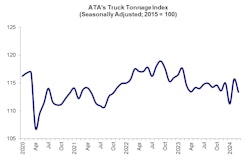As produce season ramps up, the market anticipates an impact on not only on reefer volume, but also on truckload capacity and pricing.
With May as the peak month for imports from Mexico and in particular, Florida, Dean Croke, principal analyst at DAT Freight & Analytics, noted, “It looks we’ve already passed the peak, or getting close to it a little bit earlier this year.”
“Volumes are about 6% lower year-over-year in the end of April and start of May,” Croke noted. Typically, this time of the year, Florida would produce a lot of winter vegetables, though it is lower this year. An example of this, are tomatoes, which would be one of the bigger crops this time of the year, but volumes have decreased. With volumes down, although the season isn’t definitively done, it’s not looking promising.
Produce from Mexico is another factor worth watching.
[Related: Cross-border freight on the rise at both borders]
“We get about 40% of our truckloads each week from across the Southern border,” said Croke. In April, Mexico import volumes were down about 21% year-over-year.
As the bellwether for the produce season, California should be observed, too. Though it was delayed this year because of weather, Croke said that we’re starting to see “meaningful volumes” from California.
“Their market is back on track. But will it be like Mexico and Florida, where it peaks earlier and that just translates to less truckload volume for all of us to haul,” he asked.
Croke pointed out that a part of the reason could be weaker sales on food commodities.
On whether the produce season can boost the weak freight market, Trucker Tools CEO Kary Jablonski noted it’s difficult to say for sure.
“An increase in demand during the upcoming summer months into the fall could impact rates for reefer carriers specifically, as many carriers have left the market over the recent past,” Jablonski said.
As produce volumes kick in some regions, capacity shrinks in some parts as people chase produce.
“As capacity shifts to markets with a short-term increase in demand for seasonal produce freight, other markets could likely see an increase in rates, specifically as reefer capacity shrinks,” Jablonski noted.
Typically, when carriers aren’t hauling produce, they’re hauling dry freight. When refrigerated season produce comes up, truckers in the dry freight market jump over to the produce market and haul refrigerated produce, thereby tightening capacity in the dry van market.
“This year, we’re forecasting, instead of a 25-cents per mile lift, our models are forecasting only a 10-cent per mile lift. So, it’s looking like this produce season won’t see the typical rate increase,” Croke explained. “We would normally see [an increase] around July 4 from a normal produce market, and I think that's reflective of just softer consumer demand across the board.”
Factors such as consumer confidence, interest rates, geopolitical risk and diesel prices have resulted to a soft trade market. “We see that the market is soft, and not having the same impact that we normally see around July 4,” said Croke.
On a regional level, Croke said, “You’ll see some incredible movement and capacity tightening,” noting that you have to take into account how there’s a lot more produce moving on the spot market as it’s time-sensitive and the crop harvest is weather dependent. For example, cherries are a high-cost produce. “It’s a high-risk commodity where you need specialized carriers. Those rates go through the roof around [harvest] time,” said Croke.
It’s also impacted by religious holidays like Diwali, the Hindu festival of lights, as well as other festivals, such as the Florida Strawberry Festival in late February-early March, and the Blueberry Festival in New Jersey.
“Your produce festivals across the country are kind of the markers for when that produce season in that region is at its peak, and that’s when you see capacity the tightest for the particular commodity in the region,” said Croke.
Factors such as weather and crop availability also come into play. “You do see a lot of rate volatility around harvest time at a produce growing region level,” he added.
Increased demand for trucks during peak produce seasons could lead to higher competition for available trucks and potentially, higher rates for other types of freight.
During slower produce seasons, there might be more trucks available for other types of shipments, potentially leading to lower rates.
For fleets who don’t specialize in hauling produce, Jablonski pointed out there’s other trends worth noting in the coming months. Flatbed demand will increase in the Midwest as frost laws are lifted and construction increases, he said.
“As families tend to choose to move in the summer months, many household retailers will increase demand, primarily from dry van carriers,” Jablonski said.
Jablonski noted that there could also be an increase in beer shipments from Mexico, which could be an opportunity for dry van carriers who utilize cross-border tracking technologies. “Cross-border visibility is currently a high priority for many shippers and brokers shipping cross-border freight,” he said.













